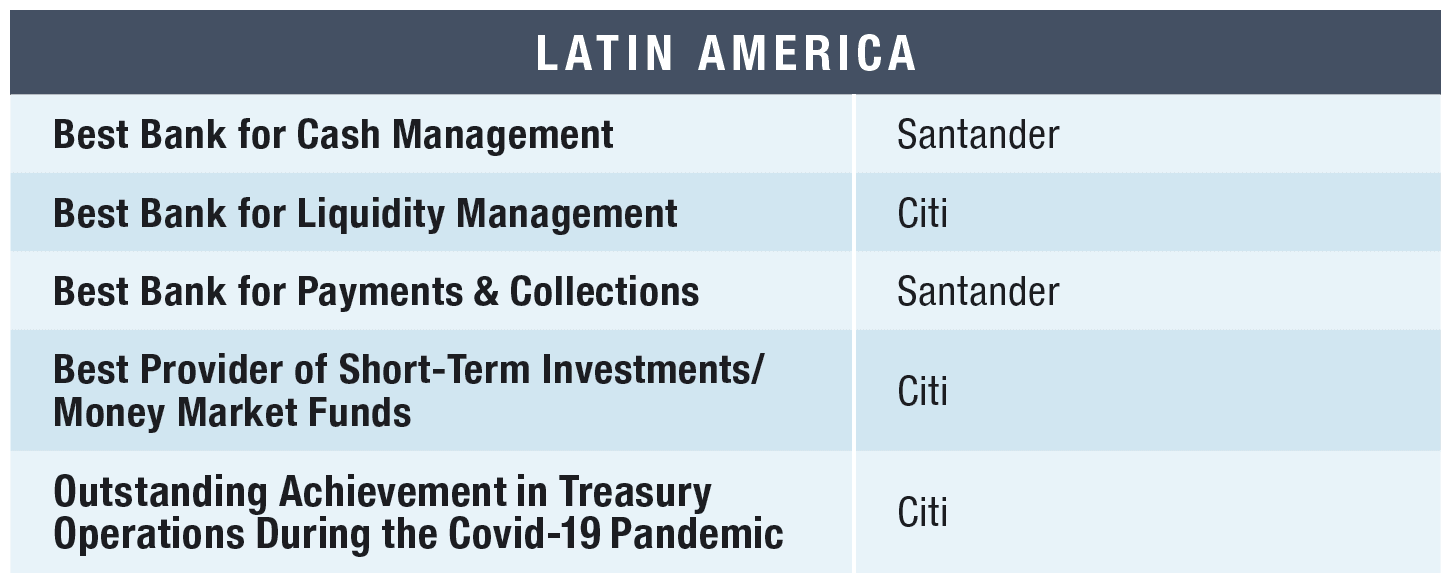Regional banks are betting cash management digitalization and better cash-flow forecasting will give clients an edge post-pandemic.

Even in the best of times, Latin America’s economy faces numerous obstacles to growth—and these are not the best of times.
The pandemic has dimmed the prospects of the region’s biggest economies: Brazil, Mexico, Argentina, Colombia, Chile and Peru. “Local cash flows have been hit dramatically, especially those related to basic transactional activities: domestic collections and payments,” says Yago Espinosa de los Monteros, global head of Cash Management at Santander Corporate and Investment Banking.
Pandemic mitigations—particularly lockdowns—have put pressure on cash flows and accelerated the need for banks to digitalize their cash management offerings to support transactional activity in economies that are still anchored to cash and checks. Santander, Global Finance’s 2021 pick for regional Best Bank for Cash Management and Best Bank for Payments and Collections, offers digital solutions that help ease the pain and pressure. These include E-Check in Argentina, Liga de Pago in Mexico, Instant Payments in Brazil, invoice digitization in Peru and digital pension payments in Chile.
To boost its presence among small to midsize enterprises (SMEs), Santander Group invested about €400 million (about $453 million) in November 2019 to acquire 50.1% of Ebury, a major payments and foreign exchange platform for SMEs that was already operating in 17 countries and with 140 currencies. Ebury is looking to enter new markets in Latin America and Asia. “Ebury’s unique product offering helps businesses to accelerate and simplify international finance,” says Espinosa, whether the client is an international trader, a nongovernmental organization, an e-commerce platform or a small-business owner.
Citi, 2021 Best Bank for Liquidity Management and Best Provider of Short-Term Investments/Money Market Funds, as well as award winner for Outstanding Achievement in Treasury Operations During the Covid-19 Pandemic, is also working to ease corporates’ cash flow headaches. While focusing on helping clients identify, manage and mitigate cash flow and liquidity risk, it also supports them through both traditional and alternative financing programs.
“Whether clients face good times or bad, they rightly expect banks’ solutions to be easy and intuitive,” says Steve Donovan, regional head of Treasury and Trade Solutions for Latin America at Citi. “To achieve this, we embarked on a targeted digital journey three years ago that resulted in a number of significant and strategic investments to digitalize our client solutions and streamline access for our clients. Digital readiness helps treasuries make better decisions; allocate resources efficiently; and reduce costly, risky manual processes. Overall, the full conversion to digital needs to be part of the treasurer’s agenda to remain competitive and thrive.”
Managing working capital is becoming a more fundamental part of the corporate ecosystem, Donovan argues, minimizing supply chain disruption and helping companies maintain competitiveness. Citi developed a range of new digital channels and tools that have been widely adopted by its clients, including cashflow forecasting enhancements, new cash management structures and reconciliation tools that improve working capital ratios and free up internal cash flows.
Focusing on cash flow and digitalization will stand banks and their clients in good stead in the post-pandemic world, specialists predict. “We believe there is a blue sky ahead of the pandemic,” says Espinosa, “and we believe in a strong recovery for all the economies in the region, where cash flows will have emerged more digitalized and transparent to all players.”




